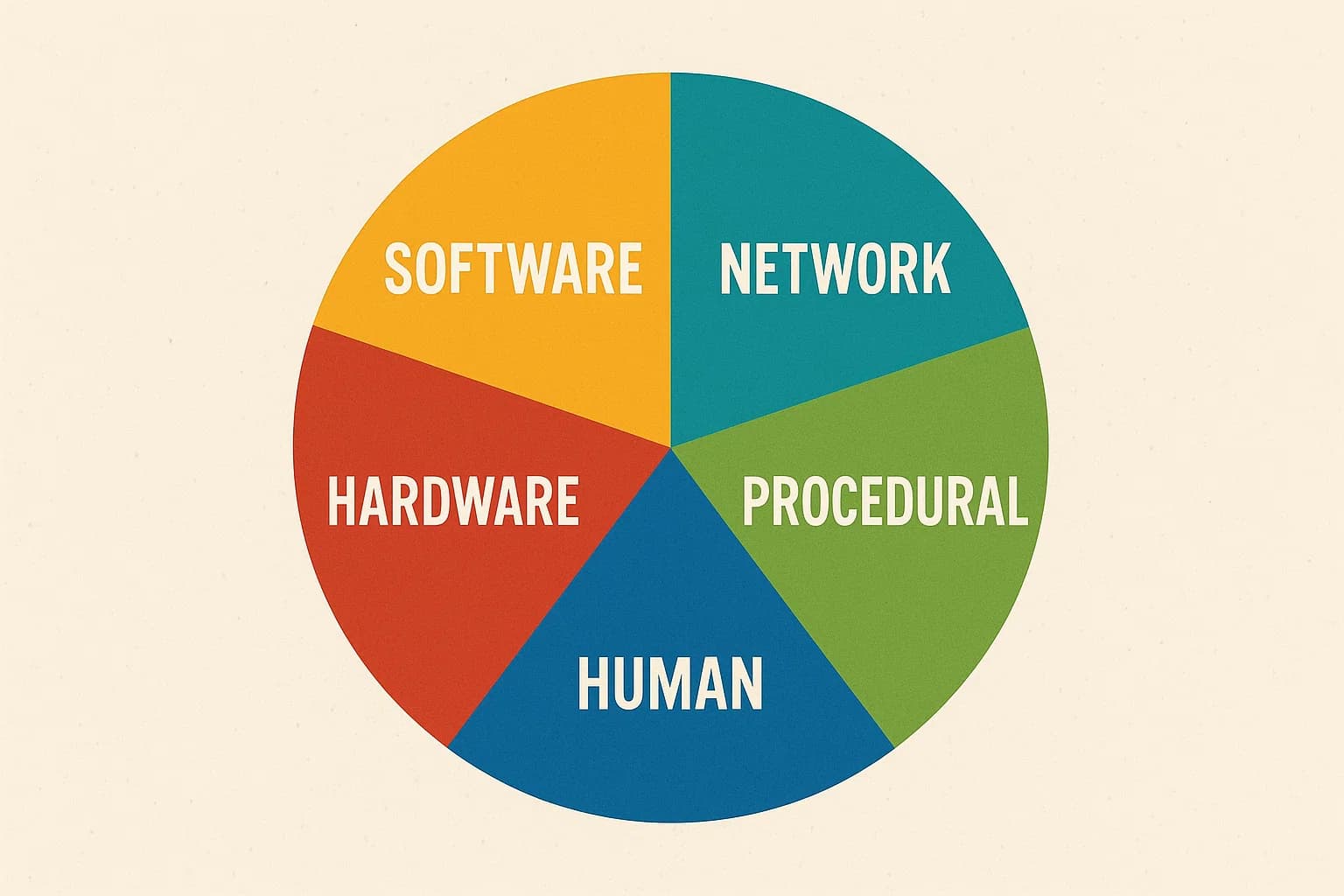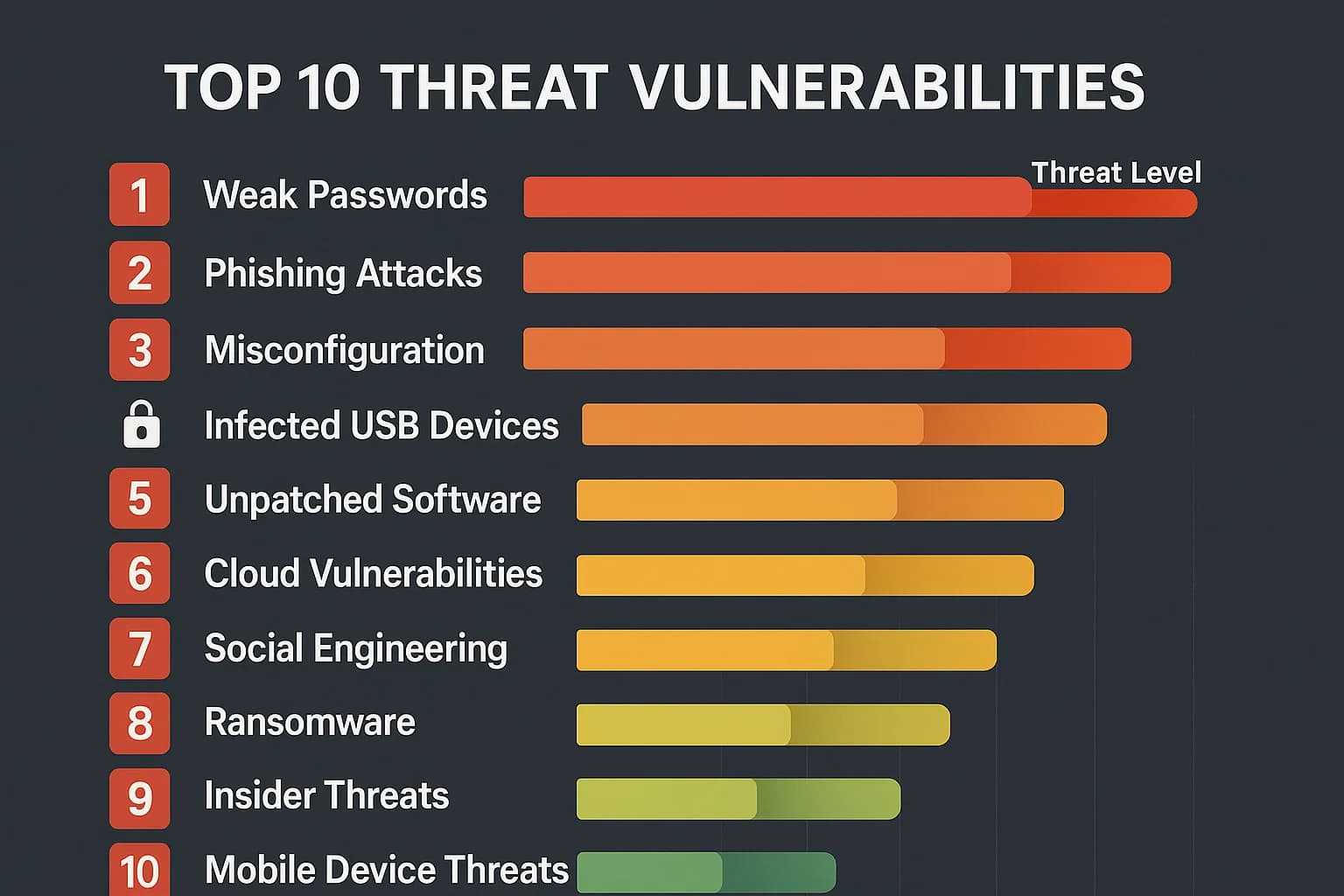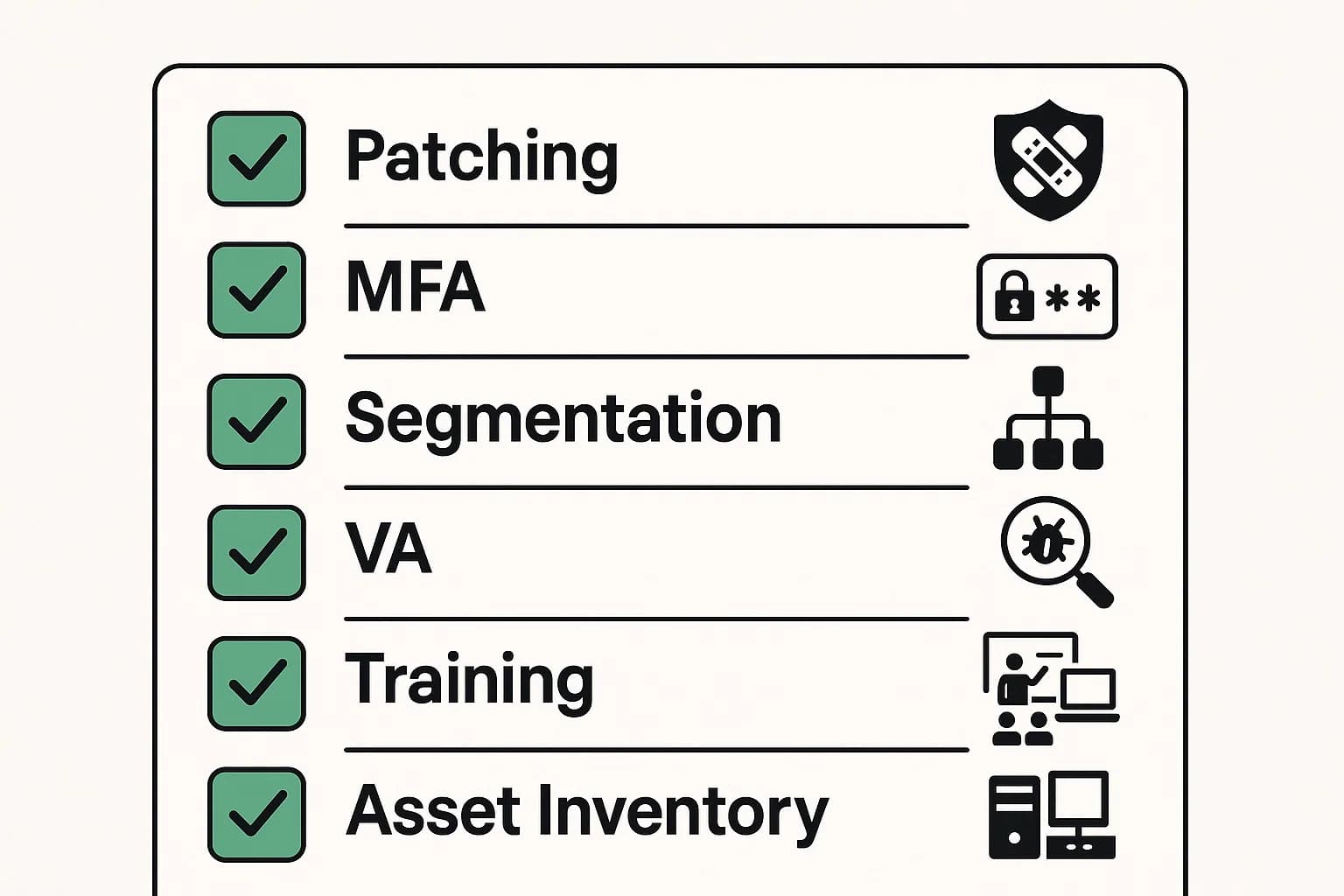May 22, 2025
In 2025, most breaches still come down to the basics unpatched systems, weak passwords, and exposed devices. This guide breaks down real risks and how to fix them before attackers find them first.
Mohammed Khalil

Attackers don’t need Hollywood level exploits to breach your network; they need a single exposed door. And in most environments, there are a lot of those doors.
According to the National Vulnerability Database (NVD), over 30,000 new vulnerabilities were reported in 2024. That’s nearly 600 fresh flaws per week, many of which were weaponized in public exploits or ransomware kits just days after disclosure.
Let that sink in: before your team even finishes triaging last month’s patch cycle, a new wave of risks is already on your doorstep.
What makes this even more dangerous in 2025:
Translation? If you’re not scanning, patching, and hardening continuously, you’re playing defense with your hands tied.
And for the record it’s not just enterprise giants being targeted. Small businesses, local governments, even startups with "nothing to steal" are seeing action. Why? Because many of them don’t even have a dedicated IT person, let alone security staff. They're low hanging fruit.
So yeah network vulnerabilities still matter. A lot. And fixing them fast is no longer optional it's survival.

The 5 Types of Vulnerabilities (And Where They Hide)
Not all vulnerabilities are created equal. Here’s a quick breakdown of where the real risks often start:
1. Hardware Vulnerabilities: Think of insecure routers, outdated firmware, or USB based malware injections. If a device isn’t locked down physically and digitally, it’s fair game.
2. Software Vulnerabilities: These show up as bugs, outdated plugins, or misconfigured apps. A single unpatched CMS plugin can be a hacker’s dream.
3. Network Vulnerabilities: From open ports to insecure Wi Fi and misconfigured firewalls your network perimeter is constantly under fire.
4. Procedural Vulnerabilities: These are process gaps like not enforcing password resets, skipping logging, or sloppy offboarding of users.
5. Human Vulnerabilities: Social engineering, weak passwords, or employees falling for deepfake voice calls humans are still the easiest way in.
Threats vs Vulnerabilities vs Exploits
Let’s clear this up (because people mix these up constantly):
Not every vulnerability is instantly dangerous. But when:
...then it’s a ticking time bomb.
And when that exploit is:
...you’re not just on the attacker’s radar you’re actively being hunted.
So while not every CVE is a red alert, it’s your job to know which ones are. Prioritize. Patch. Monitor.
Because the right vulnerability, left untouched, in the hands of the wrong person? That’s not a maybe. That’s a breach waiting to happen.
Quick Tip: Zero day vulnerabilities are flaws the vendor doesn’t even know about yet. Attackers love them because there’s no patch. But here’s the thing: most breaches don’t need a zero day. They happen because of old, ignored flaws with patches sitting in the queue.

Let’s break down the threats most likely to hit your environment this year with real world cases, quick win fixes, and practical tips you can implement today.
1. Outdated Software and Unpatched Systems
Still running legacy software? Using an old WordPress plugin "just until next quarter"? That kind of thinking opens the door to attackers.
Outdated software is the single most common vulnerability in enterprise and SMB environments alike. Tools like Shodan, Censys, and ZoomEye are constantly scanning the internet for exposed services running known vulnerable versions of Apache, Microsoft Exchange, VPN gateways, and more.
Real World Example: The infamous 2017 Equifax breach (CVE20175638) happened because of a single unpatched Apache Struts component. 147 million consumer records were exposed and the vulnerability had a patch available months before the attack.
2025 Data Point: Nearly 62% of ransomware attacks in Q1 2025 targeted outdated software vulnerabilities, often via remote code execution (RCE) flaws.
Fix It:
rack critical CVEs using NVD feeds or vulnerability intelligence platforms.”
Need help choosing the right scanning method? Here's how to compare vulnerability assessments vs. penetration tests.
2. Misconfigured Firewalls
Your firewall should be your first line of defense not an open gate.
Firewall misconfigurations are shockingly common: from overly permissive "allow all" rules, to exposed RDP ports, to unrestricted outbound traffic. Without proper segmentation, a single exposed service can become a highway into your core network.
Real World Example: A large public university was breached in 2023 after a Fortinet firewall rule allowed lateral movement between VLANs. Attackers entered through an unmonitored student services portal and within hours, had full access to HR and finance systems.
Fix It:
3. Weak Passwords & Default Credentials
Yes, this one still makes the list because it's still everywhere. Despite years of awareness campaigns, weak and reused passwords are alive and well, and attackers know it.
Credential stuffing attacks where bots use massive lists of stolen usernames and passwords are now faster, cheaper, and more effective thanks to automation and cloud based attack infrastructure. And default logins? They’re often still active in routers, security cameras, printers, and IoT gadgets across corporate environments.
Real World Example: In late 2024, a major logistics firm was compromised after attackers discovered that hundreds of remote sensors were still using default credentials. The attackers pivoted into the main network, exfiltrated customer PII, and disrupted fleet operations for five days.
2025 Insight: Over 82% of breaches analyzed in the latest Verizon DBIR involved compromised or weak credentials. That includes password reuse, shared accounts, and logins that were never deactivated.
Fix It:
4. Single Factor Authentication
Let’s say it clearly: a single password is no longer a defense, it's a liability.
In 2025, attackers don’t need to break your passwords. They can phish them, guess them, reuse them from a past breach, or steal them using malware. If your login process stops at a password prompt, then your door is wide open even if the password looks strong.
Why It Still Happens:
2025 Reality Check: Studies show that Multi Factor Authentication (MFA) blocks over 99% of password based attacks. But many companies still haven’t enabled it universally especially on admin accounts, email, and VPN access.
Recent Case: In Q1 2025, a regional law firm suffered a business email compromise (BEC) after an attacker guessed the password to an unprotected Outlook Web Access account. They used the access to send fake wire instructions to clients resulting in over $2.3 million in fraudulent transfers.
Fix It:
Authentication in 2025 isn’t just about strong passwords. It’s about layers. And the more layers you add, the less likely attackers can break through.
5. Phishing & Social Engineering
If you had to bet on how attackers get their first foothold, bet on phishing every time.
Phishing remains the #1 initial access vector in 2025. Why? Because humans are easier to trick than systems are to break. And now, with AI in the mix, phishing emails look cleaner, more personalized, and way more convincing.
Attackers aren’t just blasting out Nigerian prince emails anymore. They’re using:
Real World Example: In early 2025, a biotech startup fell victim to a phishing campaign where attackers spoofed a fake DocuSign email. A rushed executive entered credentials into a cloned login portal. Within 10 minutes, the attackers had access to internal Slack, source code repositories, and HR files.
Hard Truth: Phishing campaigns in 2025 now boast a 35% click rate, up from 19% in 2023. The rise in QR phishing and AI generated messages is making human detection harder than ever.
Fix It:
And most importantly: build a no blame reporting culture. If someone clicks, they need to report it immediately, not cover it up. Fast detection is the difference between a near miss and a full breach.
If you had to bet on how attackers get their first foothold, bet on phishing every time.”
Also check out our full breakdown of Phishing Statistics in 2025 to see just how fast these attacks are evolving.
6. Email Based Attacks
Phishing is just the start. In 2025, email is still the attacker’s favorite delivery mechanism and it’s evolving.
Threat actors now use email to drop malware payloads, harvest credentials, deliver malicious links that activate after delivery, or launch business email compromise (BEC) scams that look painfully real.
The danger isn’t just in the inbox. It’s what happens after the click:
Real World Breach: In mid2024, a healthcare provider was breached via a fake "urgent approval" email. A finance employee downloaded a macro enabled spreadsheet that silently installed malware. The result? 250,000 patient records exfiltrated before anyone noticed.
Stat Snapshot: Email is involved in over 90% of reported data breaches, whether through phishing, malware delivery, or account compromise.
Fix It:
Pro tip: Combine email protections with zero trust access rules so even if a bad file gets in, it can’t do much damage without breaking other security layers.
7. Mobile Devices & BYOD (Bring Your Own Device)
Remote work is here to stay, and so are personal devices accessing your corporate network. But while BYOD improves flexibility, it also blows up your attack surface.
The risk? Most phones, tablets, and personal laptops:
Plus, mobile phishing (a.k.a. “smishing”) is on the rise. With smaller screens and no hover preview for links, users are far more likely to fall for malicious prompts.
Remote work is here to stay, and so are personal devices accessing your corporate network. ”Check out our guide to mobile app penetration testing to stay protected.
Real World Incident: In late 2024, a sales executive clicked a spoofed Microsoft Teams invite while on a personal iPhone during travel. The attacker used the access to intercept client emails and steal sensitive contracts before IT detected the breach.
Trend Watch: 2025 has seen a 44% increase in mobile targeted attacks compared to 2023 especially in hybrid work environments.
Fix It:
Bonus tip: Integrate device health checks with your identity provider (like Okta or Azure AD) to block risky logins from outdated or compromised mobile devices.
8. IoT Vulnerabilities
Smart devices might be great for productivity and automation, but when it comes to security? They’re often a nightmare.
Internet of Things (IoT) devices from smart thermostats to connected printers and badge readers frequently ship with weak security settings, outdated firmware, and default passwords. Worse? Many of them don’t support patching at all or require manual updates that nobody schedules.
Once these devices are plugged into your network, they become silent liabilities. If not isolated properly, a hacked smart light bulb can become a stepping stone to your HR database.
Real World Breach: In Q1 2025, a ransomware gang exploited a vulnerable internet connected HVAC system in a hospital. They gained initial access through a thermostat running outdated firmware and from there, jumped into the facility’s internal network, eventually encrypting patient scheduling and billing systems.
2025 Fact: Over 37% of organizations surveyed by CISA admitted they have no inventory of IoT devices connected to their networks let alone a patching strategy.
Fix It:
Pro Tip: Use a firewall or NAC (Network Access Control) tool to block outbound connections from IoT devices unless they’re explicitly required. You’d be surprised how many "smart" things are calling home sometimes to shady places.
Once these devices are plugged into your network, they become silent liabilities.”
Wondering how to test for these flaws? See when to use internal vs external penetration testing.
9. Insider Threats
Not every breach starts with a hacker in a basement. Sometimes the biggest threat is already on your payroll.
Insider threats come in two flavors:
And here’s the catch: insider threats often fly under the radar. Why? Because the behavior might look "normal" until it’s too late.
Real World Breach: In 2024, a former employee at a software development firm retained access to staging servers after their contract ended. Two months later, they sold proprietary source code on the dark web. The incident cost the company over $1.5M in legal fees, client losses, and reputation damage.
By the Numbers: IBM's 2025 Cyber Threat Report found that insider threats now account for 27% of all breaches and the average time to detect them is 76 days.
Fix It:
Extra layer: establish a strong security culture and reporting mechanisms so employees feel comfortable flagging risky behavior without fear.
10. Shadow IT
Shadow IT isn’t just a buzzword, it's one of the most overlooked but dangerous problems in modern networks.
It refers to the software, devices, or services that employees use without the knowledge or approval of the IT or security teams. Think of things like:
These tools often fly completely under the radar bypassing all logging, monitoring, and policy enforcement. And the more your teams work remotely or across departments, the more likely Shadow IT is creeping in.
Real World Incident: A marketing intern at a retail brand used a free survey app to collect customer feedback. Turns out, the app had poor encryption and was logging all responses including names and emails to an exposed cloud bucket. The result? A data privacy investigation, fines, and brand damage.
Stat Watch: Gartner estimates that by the end of 2025, over 45% of SaaS spend will be driven by Shadow IT and less than 30% of that will be covered by enterprise security policies.
Fix It:
Remember: Shadow IT doesn’t mean people are trying to be reckless. Most of the time, they’re just trying to get work done faster. Your job is to make secure choices easy and risky shortcuts unnecessary.

Reading about vulnerabilities is one thing acting on them is what makes the difference. You don’t need a $500,000 security budget to make your environment significantly safer. You just need to start with the right things.
Here’s your 2025 top priority checklist actionable, realistic, and effective:
• Patch management:
• Enforce MFA everywhere:
• Segment and lock down your network:
• Run vulnerability assessments (then actually act on them):
• Train your people continuously:
• Inventory everything:
What’s the #1 network vulnerability in 2025? Outdated software is still the top entry point, even in large orgs.
How do hackers find vulnerabilities? They use tools like Shodan and Censys to scan for weak, exposed systems.
What’s the fastest fix? Enabling MFA and patching critical CVEs. Takes hours, saves months of cleanup.
Who’s most at risk? Small businesses and understaffed orgs often skip basic hardening steps.
Security isn’t about perfection it’s about consistency. If you:
…you’ll be miles ahead of most organizations still hoping their antivirus alone will save them.
Remember: most breaches aren’t caused by elite hackers with zero days. They happen because of known vulnerabilities left wide open.
So, fix what you can today. Monitor what you can’t. And always be ready for what’s next.
Got questions about vulnerabilities or want help hardening your environment? Feel free to reach out, always happy to help.

Stay secure with DeepStrike penetration testing services. Reach out for a quote or customized technical proposal today
Contact Us